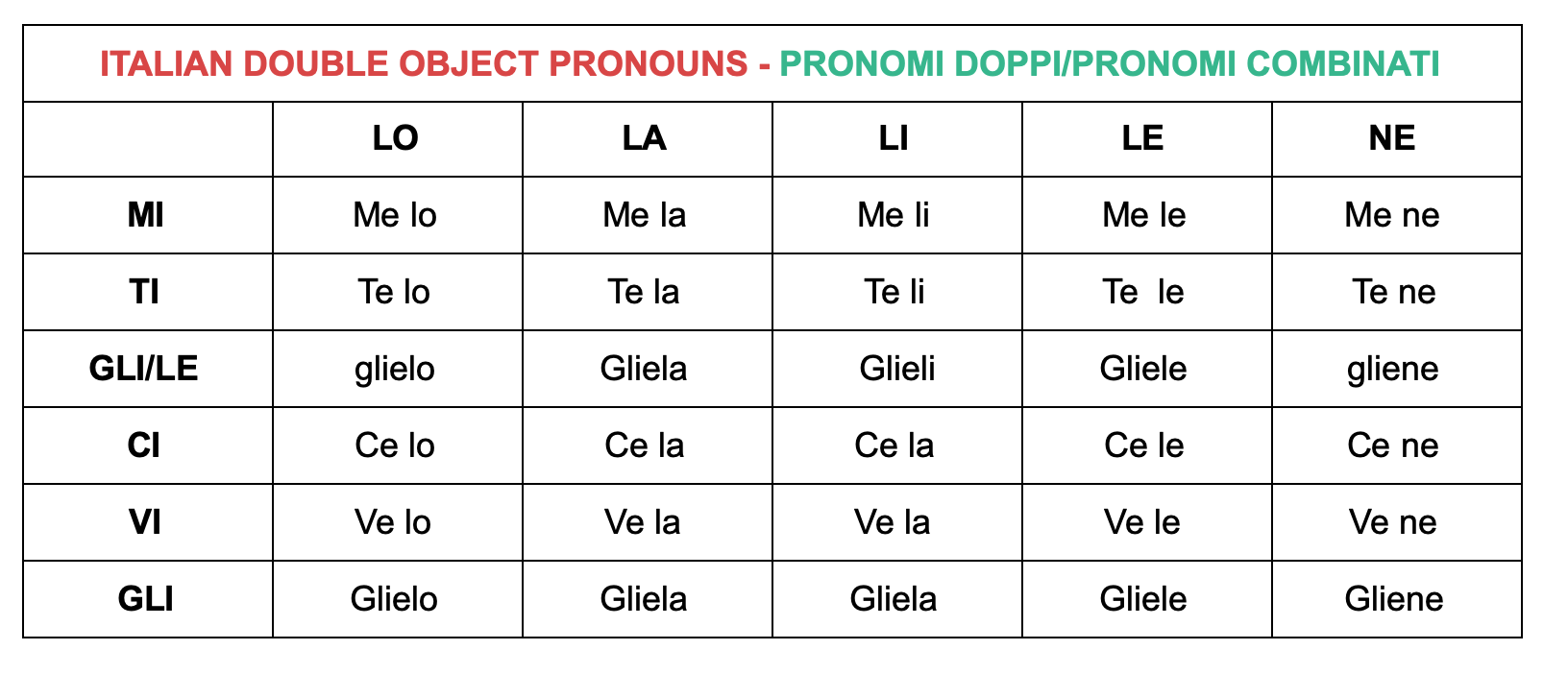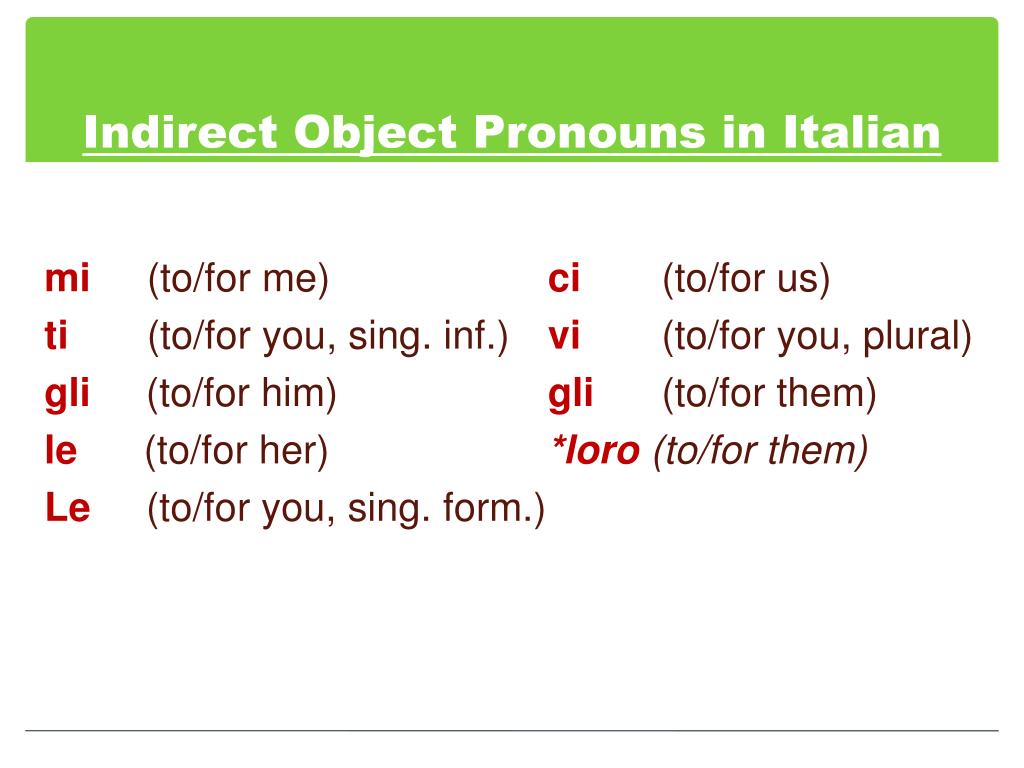
The Double Object Pronouns in Italian and How to Use Them Smart
The indirect object can be expressed by a noun (e.g. a Emma, alla sua amica) or a pronoun, which is therefore called an indirect object pronoun or simply an indirect pronoun (e.g. le ). Pronouns are short words that usually replace a noun to avoid repetition. In the following example, a Emma is replaced by the indirect object pronoun le.

Italian Verbs With Direct or Indirect Object Instantly Italy
Check out my Beginner's Course here: https://bit.ly/3bSxYWoLet's learn direct and indirect object pronouns in Italian and how to use them correctly. We'll le.

Pin on Итальянский язык
We know about direct object pronouns, so what about indirect object pronouns? Wait, what's an indirect object? Let's straighten out some English grammar firs.

Italian Indirect Object Pronouns — Weilà!
Indirect object pronouns, just like direct object pronouns, precede a conjugated verb, except for loro and Loro, which follow the verb. Le ho dato tre ricette. - I gave her three recipes. Ci offrono un caffè. - They offer us a cup of coffee. Parliamo loro domani. - We'll talk to them tomorrow. A: Che cosa regali allo zio Giovanni?

Italian Indirect Object Pronouns A Simple Guide Learn Italian Go
Indirect object pronouns answer the question "to whom"? or "for whom"? Using indirect object pronouns in place of the noun can help spoken and written language flow more naturally.. Italian grammar lesson on indirect object pronouns. How to use them? Simple notes for beginners with rules, examples, conjugations, sentences, and.

Italian indirect object pronouns Archives Learn Italian Go
Indirect object pronouns ( pronomi complemento indiretto) are pronouns that substitute for nouns that serve as the indirect object of the sentence verb, indicating to whom or to what (or for whom or for what, with whom or with what, etc.) an action was done.

Pin on FAVE PLACES
Italian indirect pronouns. First of all, let's have a look at the classic definition of pronoun: a pronoun is a variable part of the speech used in place of a noun. Plus, Italian pronouns can be direct and indirect and they can refer, directly or indirectly, to people or things named in speech or they can even refer to an entire sentence.

indirect object pronouns italian
An indirect object is the person (or thing) the action is directed to. For example, if you send a letter to Maria, she is NOT the object of the action (because the letter is) but the person to whom the action is directed to! You send the object of the action (the letter) to a person, Maria.

Italian Indirect Object Pronouns A Simple Guide Learn Italian Go
Indirect Object Pronouns in Italian Indirect Object Pronouns in Italian: Vocabulary Mi = to me/for me Ti = to you/for you Gli = to him/for him Le = to her/for her Ci = to us/for us Vi = to you/for you (plural "you", when speaking to two or more people) Gli = to them/for them Do = I give Questo = this Ti = to you/for you

Direct and Indirect Object Pronouns Italian Exercises
The best way to understand the differences is by seeing lots of examples. But first let me introduce you guys to the Indirect Object Pronouns: Mi - a me (to me) Ti - a te (to you) Gli - a lui (to him) Le - a lei (to her) Ci - a noi (to us) Vi - a voi (to you guys/you all) Gli - a loro (to them)

PPT Indirect Object Pronouns PowerPoint Presentation, free download
Indirect Object Pronouns in Italian. L'Italiano Porticando. Thu, 08/26/2021 - 04:20. In one of our previous articles, we got to know the direct object pronouns in Italian and learned how to use them correctly. As you may remember, direct object pronouns indicate a person or a thing affected by some action: Scrivo la lettera - La scrivo.

Italian Indirect Object Pronouns A Simple Guide Learn Italian Go
Indirect pronouns have the function of indirect object.Therefore, they are used when the verb is followed by the preposition " a " (to) and they answer the question "To whom? To what?". For example: Miriana ha telefonato a Luca = Miriana gli ha telefonato (Miriana phoned Luca = Miriana phoned him). In this case, the indirect pronoun gli replaces the indirect object: "a Luca".

Italian Indirect Object Pronouns A Simple Guide Learn Italian Go
An Indirect Object tells whom the action described by the verb is directed to, performed for or intended to benefit or harm. The Indirect Object also indicates the person or thing that receives the direct object. The basic construction of Italian Indirect Object Pronouns works with Subject + verb + direct object + indirect object.

The direct object pronouns Smart Italian Learning
Indirect objects are nouns or noun substitutes that typically need a preposition to make the phrase meaningful. For example: " I speak to Laura " becomes meaningless if we say " I speak Laura ." Pronouns that stand for or replace an indirect object are called indirect object pronouns
/GettyImages-645446997-576f2ff65f9b585875db6b82.jpg)
Indirect Object Pronouns in Italian
What are the Italian indirect object pronouns, and how do they work? A pronoun is a part of speech that replaces a name or a person to avoid repeating them directly in a sentence. This is why they are called pronomi in Italian, from the Latin pro, "in place of", and nomen, "name". Ho regalato a mamma una matita. Le ho regalato una matita.

Pronomi oggetto indiretti Lingua italiana, Imparare l'italiano
These are used with verbs that do not take the preposition 'a' in Italian. Some verbs that take direct object pronouns In Italian, that are actually indirect in English: Ascoltare - to listen to. Aspettare - to wait for. Cercare - to search for. Guardare - to look at. Notice there is no need for the preposition in Italian!